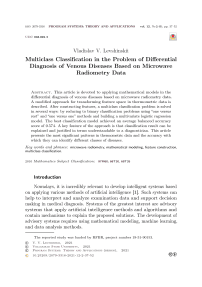Multiclass Classification in the Problem of Differential Diagnosis of Venous Diseases Based on Microwave Radiometry Data
Автор: Vladislav V. Levshinskii
Журнал: Программные системы: теория и приложения @programmnye-sistemy
Рубрика: Искусственный интеллект, интеллектуальные системы, нейронные сети
Статья в выпуске: 2 (49) т.12, 2021 года.
Бесплатный доступ
This article is devoted to applying mathematical models in the differential diagnosis of venous diseases based on microwave radiometry data. A modified approach for transforming feature space in thermometric data is described. After constructing features, a multiclass classification problem is solved in several ways: by reducing to binary classification problems using “one versus rest” and “one versus one” methods and building a multivariate logistic regression model. The best classification model achieved an average balanced accuracy score of 0.574. A key feature of the approach is that classification result can be explained and justified in terms understandable to a diagnostician. This article presents the most significant patterns in thermometric data and the accuracy with which they can identify different classes of diseases.
Microwave radiometry, mathematical modeling, feature construction, multiclass classification.
Короткий адрес: https://sciup.org/143173914
IDR: 143173914 | УДК: 004.891.3 | DOI: 10.25209/2079-3316-2021-12-2-37-52
Список литературы Multiclass Classification in the Problem of Differential Diagnosis of Venous Diseases Based on Microwave Radiometry Data
- Roadmap for the development of “Pass-through” digital technology “Neurotechnologies and Artificial Intelligence”, Ministry of Digital Development, Communications and Mass Media of the Russian Federation, 2019 (in Russian).
- M. Sedankin, A. Gudkov, V. Leushin, S. Vesnin, I. Sidorov, D. Chupina, S. Agasieva, V. Skuratov, S. Chizhikov. “Microwave radiometry of the pelvic organs”, Biomedical Engineering, 53:4 (2019), pp. 288–292.
- A.V. Tarakanov, A.A. Tarakanov, S. Vesnin, V. Efremov, N. Roberts, I. Goryanin. “Influence of ambient temperature on recording of skin and deep tissue temperature in region of lumbar spine”, European Journal of Molecular & Clinical Medicine, 7:1 (2020), pp. 21–26.
- I. Goryanin, S. Karbainov, O. Shevelev, A. Tarakanov, K. Redpath, S. Vesnin, Y. Ivanov. “Passive microwave radiometry in biomedical studies”, Drug Discovery Today, 25:4 (2020), pp. 757–763.
- T.V. Zamechnik, S.I. Larin, A.G. Losev. Combined radiothermometry as a method for studying venous circulation of the lower extremities, monograph, VolgGMU Publishing House, Volgograd, 2015, ISBN 978-5-9652-0400-7 (in Russian), 252 pp.
- T.V. Zamechnik, N.S. Ovcharenko, S.I. Larin, A.G. Losev. “Reliability assessment of combined thermography as a method for the characteristic of the lower limb venous system”, Flebologiya. Journal of Venous Disorders, 4:3 (2010), pp. 23–26 (in Russian).
- E.V. Anisimova, T.V. Zamechnik, A.G. Losev. “About one mathematical model of diagnostics of venous diseases according to the combined thermometry”, Bulletin of new medical technologies, 19:2 (2012), pp. 239–241 (in Russian).
- T.A. Stavrov, E.V. Bukina, A.G. Losev, T.V. Zamechnik. “Mathematical verification of early recurrence of the varicose disease after the endovascular laser obliteration of the great saphenous vein according to data of the radiothermometry”, Bulletin of new medical technologies, 20:2 (2013), pp. 14–18 (in Russian).
- A.G. Losev, V.V. Levshinsky. “The thermometry data mining in the diagnostics of mammary glands”, Large-Scale Systems Control, 70 (2017), pp. 113–135 (in Russian).
- V. Levshinskii. “Intelligent system for diagnostics of venous diseases based on the microwave radiothermometry data”, “Smart Technologies” for Society, State and Economy, ISC 2020, Lecture Notes in Networks and Systems, vol. 155, eds. E. G. Popkova, B. S. Sergi, Springer, Cham, 2021, pp. 212–219.
- [11] E.A. Mazepa, O.V. Grishina, V.V. Levshinsky, H.M. Suleymanova. “The unification of microvawe radio thermometry method”, Mathematical Physics and Computer Simulation, 20:6 (2017), pp. 38–50 (in Russian).
- D.A. Vedenyapin, A.G. Losev. “Neural networks in vascular diseases diagnosis”, Large-Scale Systems Control: collection of works, 39 (2012), pp. 219–229 (in Russian).
- K.V. Vorontsov. Lectures on logical classification algorithms, 2007 (in Russian), 53 pp.
- P. Flach. Machine Learning. The Art and Science of Algorithms that Make Sense of Data, 1st Edition, Cambridge University Press, 2012, ISBN 978-1107422223, 409 pp.
- S. Raschka, V. Mirjalili. Python Machine Learning: Machine Learning and Deep Learning with Python, scikit-learn, and TensorFlow 2, 3rd Ed., Packt Publishing, Birmingham, UK, 2019, ISBN 978-1789955750, 770 pp.
- M. Grandini, E. Bagli, G. Visani. Metrics for multi-class classification: an overview, 2020, 17 pp.


